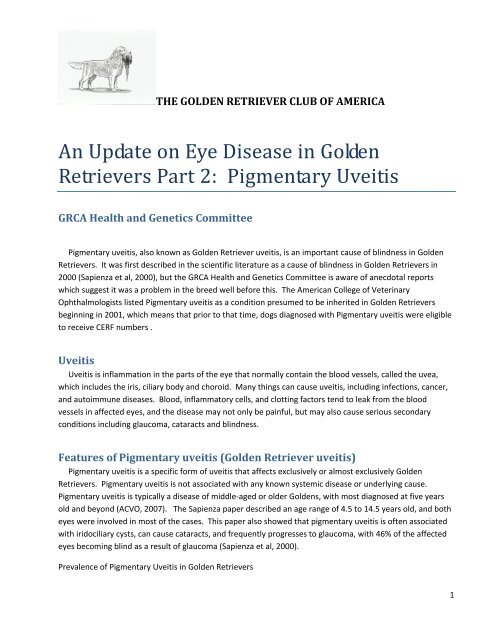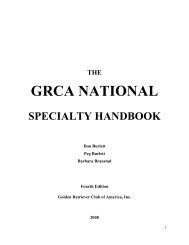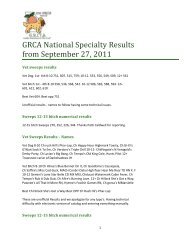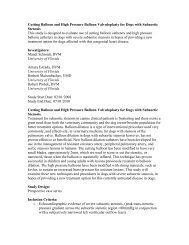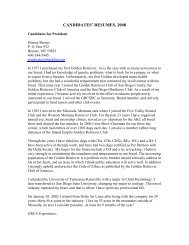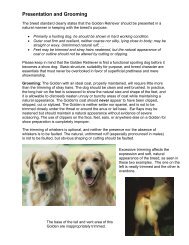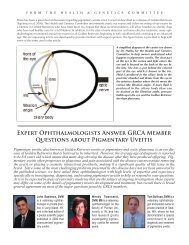Pigmentary Uveitis - Golden Retriever Club of America
Pigmentary Uveitis - Golden Retriever Club of America
Pigmentary Uveitis - Golden Retriever Club of America
Create successful ePaper yourself
Turn your PDF publications into a flip-book with our unique Google optimized e-Paper software.
THE GOLDEN RETRIEVER CLUB OF AMERICA<br />
An Update on Eye Disease in <strong>Golden</strong><br />
<strong>Retriever</strong>s Part 2: <strong>Pigmentary</strong> <strong>Uveitis</strong><br />
GRCA Health and Genetics Committee<br />
<strong>Pigmentary</strong> uveitis, also known as <strong>Golden</strong> <strong>Retriever</strong> uveitis, is an important cause <strong>of</strong> blindness in <strong>Golden</strong><br />
<strong>Retriever</strong>s. It was first described in the scientific literature as a cause <strong>of</strong> blindness in <strong>Golden</strong> <strong>Retriever</strong>s in<br />
2000 (Sapienza et al, 2000), but the GRCA Health and Genetics Committee is aware <strong>of</strong> anecdotal reports<br />
which suggest it was a problem in the breed well before this. The <strong>America</strong>n College <strong>of</strong> Veterinary<br />
Ophthalmologists listed <strong>Pigmentary</strong> uveitis as a condition presumed to be inherited in <strong>Golden</strong> <strong>Retriever</strong>s<br />
beginning in 2001, which means that prior to that time, dogs diagnosed with <strong>Pigmentary</strong> uveitis were eligible<br />
to receive CERF numbers .<br />
<strong>Uveitis</strong><br />
<strong>Uveitis</strong> is inflammation in the parts <strong>of</strong> the eye that normally contain the blood vessels, called the uvea,<br />
which includes the iris, ciliary body and choroid. Many things can cause uveitis, including infections, cancer,<br />
and autoimmune diseases. Blood, inflammatory cells, and clotting factors tend to leak from the blood<br />
vessels in affected eyes, and the disease may not only be painful, but may also cause serious secondary<br />
conditions including glaucoma, cataracts and blindness.<br />
Features <strong>of</strong> <strong>Pigmentary</strong> uveitis (<strong>Golden</strong> <strong>Retriever</strong> uveitis)<br />
<strong>Pigmentary</strong> uveitis is a specific form <strong>of</strong> uveitis that affects exclusively or almost exclusively <strong>Golden</strong><br />
<strong>Retriever</strong>s. <strong>Pigmentary</strong> uveitis is not associated with any known systemic disease or underlying cause.<br />
<strong>Pigmentary</strong> uveitis is typically a disease <strong>of</strong> middle‐aged or older <strong>Golden</strong>s, with most diagnosed at five years<br />
old and beyond (ACVO, 2007). The Sapienza paper described an age range <strong>of</strong> 4.5 to 14.5 years old, and both<br />
eyes were involved in most <strong>of</strong> the cases. This paper also showed that pigmentary uveitis is <strong>of</strong>ten associated<br />
with iridociliary cysts, can cause cataracts, and frequently progresses to glaucoma, with 46% <strong>of</strong> the affected<br />
eyes becoming blind as a result <strong>of</strong> glaucoma (Sapienza et al, 2000).<br />
Prevalence <strong>of</strong> <strong>Pigmentary</strong> <strong>Uveitis</strong> in <strong>Golden</strong> <strong>Retriever</strong>s<br />
1
The Health and Genetics Committee is receiving increasing numbers <strong>of</strong> inquiries about pigmentary uveitis<br />
from the GRCA membership. Several members have discussed pigmentary uveitis with ophthalmologists<br />
who are also reporting an increased frequency <strong>of</strong> pigmentary uveitis. However, because pigmentary uveitis<br />
is <strong>of</strong>ten diagnosed at an ophthalmologist’s <strong>of</strong>fice due to clinical symptoms instead <strong>of</strong> at well‐dog CERF<br />
screening clinics, many or most cases are not tracked at a central database. Therefore, we currently do not<br />
have accurate incidence information, and this will be discussed further below.<br />
Importance <strong>of</strong> Early Detection<br />
Early detection is important for obtaining the most effective treatment. However, signs <strong>of</strong> pigmentary<br />
uveitis are <strong>of</strong>ten subtle and may be confused with less serious conditions, such as conjunctivitis. Owners<br />
<strong>of</strong>ten fail to notice anything different about affected <strong>Golden</strong> <strong>Retriever</strong>s until it is too late to save vision. In<br />
some cases there are no signs noticed by owners. In other cases, the eyes may be reddened or there may be<br />
a mild discharge. Therefore, all <strong>Golden</strong> <strong>Retriever</strong>s should have yearly eye examinations by a veterinary<br />
ophthalmologist. These exams should begin prior to breeding for breeding dogs, but pet owners may wish to<br />
begin these yearly exams at about 4‐5 years <strong>of</strong> age. In addition, <strong>Golden</strong> <strong>Retriever</strong>s with unexplained tearing<br />
or redness <strong>of</strong> the eye should be examined by an ophthalmologist promptly. There are treatments available<br />
and because untreated pigmentary uveitis is painful, <strong>of</strong>ten progresses to blindness, and treatments vary in<br />
effectiveness, early consultation with a veterinary ophthalmologist is important both for obtaining a<br />
definitive diagnosis and the best chance for preserving vision.<br />
Breeding Considerations<br />
Because pigmentary uveitis <strong>of</strong>ten develops after the prime reproductive years, it is difficult to control<br />
in breeding programs. Further, we do not yet understand the mode <strong>of</strong> inheritance <strong>of</strong> pigmentary uveitis, so<br />
the most prudent prevention strategy is to plan breedings that minimize the genetic contribution <strong>of</strong> affected<br />
dogs and their close relatives. For current breeders, this involves diligent investigation into the results <strong>of</strong> eye<br />
examinations <strong>of</strong> direct ancestors and their siblings in old age. For owners <strong>of</strong> all <strong>Golden</strong>s that have been bred<br />
in the past, this requires that eye examinations are continued throughout the dog’s lifetime so that their<br />
status is known. And to complete the flow <strong>of</strong> information between breeders, owners should register normal<br />
results with CERF so that the data is available to all subsequent generations via searchable online databases.<br />
(Please see http://grca.org/health/eyes.html for a more complete policy statement <strong>of</strong> a breeder’s<br />
responsibilities regarding lifelong eye examinations.)<br />
In addition, the Health and Genetics Committee strongly recommends that all ophthalmology<br />
examinations (other than perhaps for trauma) include a Canine Eye Registration Foundation (CERF) report. If<br />
the dog has genetic eye disease and is ineligible for a CERF number, the owner does not need to submit the<br />
owner copy to CERF, but the ophthalmologist will submit the CERF copy. CERF does not disclose the identity<br />
<strong>of</strong> affected dogs. However, these reports allow CERF and GRCA to track the frequency <strong>of</strong> eye disease in<br />
general, as well as the frequency <strong>of</strong> specific forms <strong>of</strong> eye disease, such as pigmentary uveitis, in <strong>Golden</strong><br />
<strong>Retriever</strong>s. This aggregate information helps us better understand how eye diseases impact the breed, may<br />
help us become more rapidly aware <strong>of</strong> emerging diseases, and aids in funding decisions regarding research<br />
projects. Owners and breeders can search the CERF database to verify whether or not a dog <strong>of</strong> interest has<br />
passed an ophthalmologist’s exam and is in the database (search engine is online at<br />
http://www.vmdb.org/verify.html).<br />
2
Research<br />
We have been very fortunate to have veterinary ophthalmologist Dr. Wendy Townsend, Assistant<br />
Pr<strong>of</strong>essor <strong>of</strong> Comparative Ophthalmology at Michigan State University, investigating pigmentary uveitis. And<br />
we are very grateful to the owners <strong>of</strong> dogs with pigmentary uveitis who have submitted DNA samples,<br />
pedigrees, and diagnostic information to Dr Townsend. At this time, Dr Townsend is no longer collecting<br />
DNA samples because the project is in the analysis stage, and we look forward to her findings. However,<br />
there will still be much work to be done, and we urgently request that owners <strong>of</strong> affected dogs submit blood<br />
samples to the Canine Health Information Center (CHIC) DNA repository for use in future research. The CHIC<br />
DNA repository collects DNA samples, pedigrees and health histories from dogs for use in approved research<br />
projects and is an effort designed to reduce inherited diseases in dogs. More information on the CHIC DNA<br />
repository is available online at http://www.caninehealthinfo.org/dnabank.html. Sample submission is free<br />
for affected dogs, and arrangements should be made through Eddie Dzuik at EDziuk@OFFA.org. In addition,<br />
it is usually very helpful to researchers to have DNA samples from unaffected first degree relatives (parents,<br />
siblings, <strong>of</strong>fspring). This disease is extremely challenging to control without a DNA test, so owner<br />
participation in research is vital to the control <strong>of</strong> pigmentary uveitis.<br />
References<br />
ACVO (<strong>America</strong>n College <strong>of</strong> Veterinary Ophthalmologists). Ocular Disorders Presumed to be Inherited in<br />
Purebred Dogs, Fifth Edition. ACVO. West Lafayette, IN, 2007<br />
Sapienza J, Simo FJ, Prade‐Sapienza A. <strong>Golden</strong> <strong>Retriever</strong> <strong>Uveitis</strong>: 75 cases (1994‐1999). Vet Ophthal. 4:241‐<br />
246, 2000.<br />
<strong>Pigmentary</strong> <strong>Uveitis</strong>: Frequently Asked Questions<br />
Dr. Wendy Townsend, Assistant Pr<strong>of</strong>essor <strong>of</strong> Comparative Ophthalmology at Michigan State University and a<br />
pigmentary uveitis researcher has graciously agreed to answer some <strong>of</strong> the questions commonly asked about<br />
pigmentary uveitis.<br />
Many dogs diagnosed with PU come from lines with a long pedigree history <strong>of</strong> normal eye examinations and<br />
no known prior PU. How certain are ophthalmologists that this is an inherited disease, and on what is this<br />
based?<br />
We strongly suspect that the disease is inherited because we don’t see a condition that really looks exactly<br />
like this in any other breed. If we were dealing with an infectious cause, etc. we would expect to see it in<br />
other breeds. Also from my discussion with ophthalmologists in the UK, the condition if very infrequently<br />
seen in the <strong>Golden</strong> <strong>Retriever</strong> population there. We also have pedigrees in which we can trace the condition<br />
for several generations. In those pedigrees in which there are large gaps (or long histories <strong>of</strong> normal) it could<br />
be that we have some individuals that were going to express the disease but unfortunately died due to other<br />
conditions before pigmentary uveitis could develop.<br />
3
Is there any additional information or comments that you would like to share with<br />
our membership and other <strong>Golden</strong> owners?<br />
Because <strong>Golden</strong>s with pigmentary uveitis <strong>of</strong>ten have iris cysts, if iris cysts are noted on a CERF examination,<br />
those dogs should be monitored very closely. While the presence <strong>of</strong> iris cysts does not mean that an<br />
individual will go on to develop pigmentary uveitis, almost all <strong>Golden</strong>s with pigmentary uveitis do have the<br />
iris cysts. Therefore I recommend owners <strong>of</strong> those dogs have their eyes examined every 6 months or sooner<br />
if they notice any redness, discharge, etc. as those may signal early signs <strong>of</strong> pigmentary uveitis.<br />
4


